Crime Reduction & Community Safety: Recording Crime, Community Policing, and Crime Reduction Strategies
VerifiedAdded on 2023/06/13
|11
|3692
|128
AI Summary
This report covers the recording of crime, the philosophy of community policing, and the effectiveness of crime reduction strategies. It discusses the strengths and weaknesses of using police recorded crime and CSEW to measure crime rates accurately, the impact of news media on communities' perceptions of crime, and the associated legislation. It also evaluates the impact of multi-agency policing and identifies local and national crime reduction strategies.
Contribute Materials
Your contribution can guide someone’s learning journey. Share your
documents today.

Crime Reduction &
Community Safety
Community Safety
Secure Best Marks with AI Grader
Need help grading? Try our AI Grader for instant feedback on your assignments.
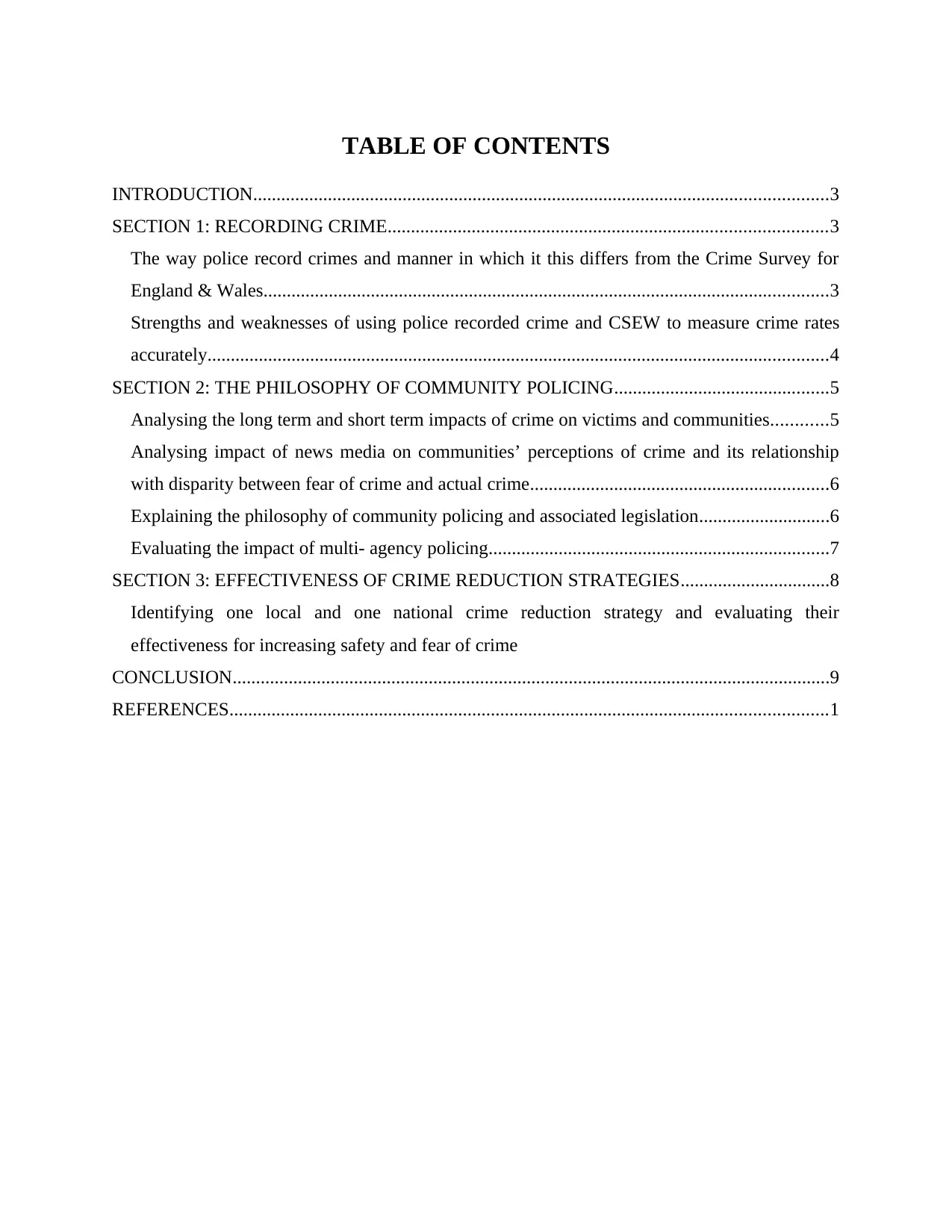
TABLE OF CONTENTS
INTRODUCTION...........................................................................................................................3
SECTION 1: RECORDING CRIME..............................................................................................3
The way police record crimes and manner in which it this differs from the Crime Survey for
England & Wales.........................................................................................................................3
Strengths and weaknesses of using police recorded crime and CSEW to measure crime rates
accurately.....................................................................................................................................4
SECTION 2: THE PHILOSOPHY OF COMMUNITY POLICING..............................................5
Analysing the long term and short term impacts of crime on victims and communities............5
Analysing impact of news media on communities’ perceptions of crime and its relationship
with disparity between fear of crime and actual crime................................................................6
Explaining the philosophy of community policing and associated legislation............................6
Evaluating the impact of multi- agency policing.........................................................................7
SECTION 3: EFFECTIVENESS OF CRIME REDUCTION STRATEGIES................................8
Identifying one local and one national crime reduction strategy and evaluating their
effectiveness for increasing safety and fear of crime
CONCLUSION................................................................................................................................9
REFERENCES................................................................................................................................1
INTRODUCTION...........................................................................................................................3
SECTION 1: RECORDING CRIME..............................................................................................3
The way police record crimes and manner in which it this differs from the Crime Survey for
England & Wales.........................................................................................................................3
Strengths and weaknesses of using police recorded crime and CSEW to measure crime rates
accurately.....................................................................................................................................4
SECTION 2: THE PHILOSOPHY OF COMMUNITY POLICING..............................................5
Analysing the long term and short term impacts of crime on victims and communities............5
Analysing impact of news media on communities’ perceptions of crime and its relationship
with disparity between fear of crime and actual crime................................................................6
Explaining the philosophy of community policing and associated legislation............................6
Evaluating the impact of multi- agency policing.........................................................................7
SECTION 3: EFFECTIVENESS OF CRIME REDUCTION STRATEGIES................................8
Identifying one local and one national crime reduction strategy and evaluating their
effectiveness for increasing safety and fear of crime
CONCLUSION................................................................................................................................9
REFERENCES................................................................................................................................1
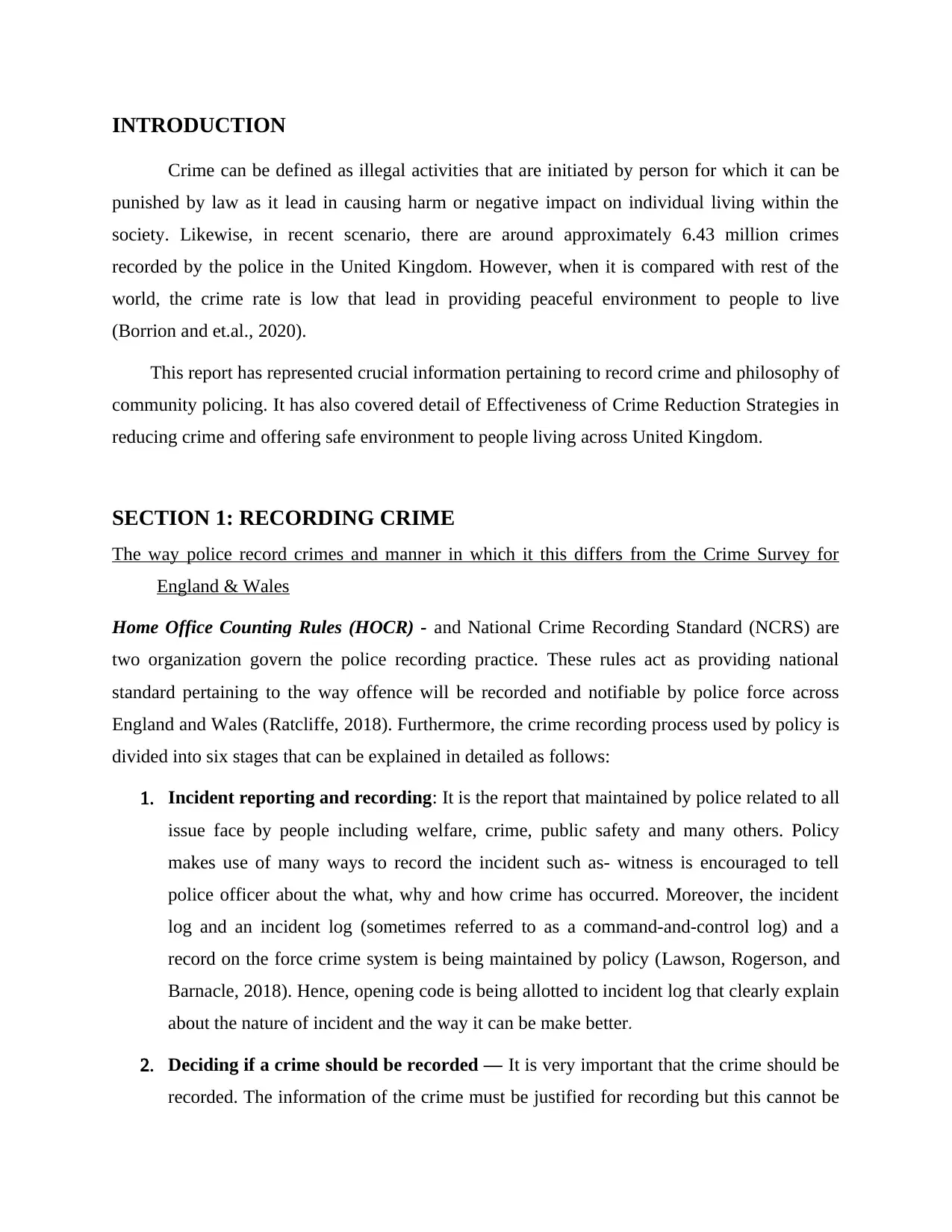
INTRODUCTION
Crime can be defined as illegal activities that are initiated by person for which it can be
punished by law as it lead in causing harm or negative impact on individual living within the
society. Likewise, in recent scenario, there are around approximately 6.43 million crimes
recorded by the police in the United Kingdom. However, when it is compared with rest of the
world, the crime rate is low that lead in providing peaceful environment to people to live
(Borrion and et.al., 2020).
This report has represented crucial information pertaining to record crime and philosophy of
community policing. It has also covered detail of Effectiveness of Crime Reduction Strategies in
reducing crime and offering safe environment to people living across United Kingdom.
SECTION 1: RECORDING CRIME
The way police record crimes and manner in which it this differs from the Crime Survey for
England & Wales
Home Office Counting Rules (HOCR) - and National Crime Recording Standard (NCRS) are
two organization govern the police recording practice. These rules act as providing national
standard pertaining to the way offence will be recorded and notifiable by police force across
England and Wales (Ratcliffe, 2018). Furthermore, the crime recording process used by policy is
divided into six stages that can be explained in detailed as follows:
1. Incident reporting and recording: It is the report that maintained by police related to all
issue face by people including welfare, crime, public safety and many others. Policy
makes use of many ways to record the incident such as- witness is encouraged to tell
police officer about the what, why and how crime has occurred. Moreover, the incident
log and an incident log (sometimes referred to as a command-and-control log) and a
record on the force crime system is being maintained by policy (Lawson, Rogerson, and
Barnacle, 2018). Hence, opening code is being allotted to incident log that clearly explain
about the nature of incident and the way it can be make better.
2. Deciding if a crime should be recorded — It is very important that the crime should be
recorded. The information of the crime must be justified for recording but this cannot be
Crime can be defined as illegal activities that are initiated by person for which it can be
punished by law as it lead in causing harm or negative impact on individual living within the
society. Likewise, in recent scenario, there are around approximately 6.43 million crimes
recorded by the police in the United Kingdom. However, when it is compared with rest of the
world, the crime rate is low that lead in providing peaceful environment to people to live
(Borrion and et.al., 2020).
This report has represented crucial information pertaining to record crime and philosophy of
community policing. It has also covered detail of Effectiveness of Crime Reduction Strategies in
reducing crime and offering safe environment to people living across United Kingdom.
SECTION 1: RECORDING CRIME
The way police record crimes and manner in which it this differs from the Crime Survey for
England & Wales
Home Office Counting Rules (HOCR) - and National Crime Recording Standard (NCRS) are
two organization govern the police recording practice. These rules act as providing national
standard pertaining to the way offence will be recorded and notifiable by police force across
England and Wales (Ratcliffe, 2018). Furthermore, the crime recording process used by policy is
divided into six stages that can be explained in detailed as follows:
1. Incident reporting and recording: It is the report that maintained by police related to all
issue face by people including welfare, crime, public safety and many others. Policy
makes use of many ways to record the incident such as- witness is encouraged to tell
police officer about the what, why and how crime has occurred. Moreover, the incident
log and an incident log (sometimes referred to as a command-and-control log) and a
record on the force crime system is being maintained by policy (Lawson, Rogerson, and
Barnacle, 2018). Hence, opening code is being allotted to incident log that clearly explain
about the nature of incident and the way it can be make better.
2. Deciding if a crime should be recorded — It is very important that the crime should be
recorded. The information of the crime must be justified for recording but this cannot be
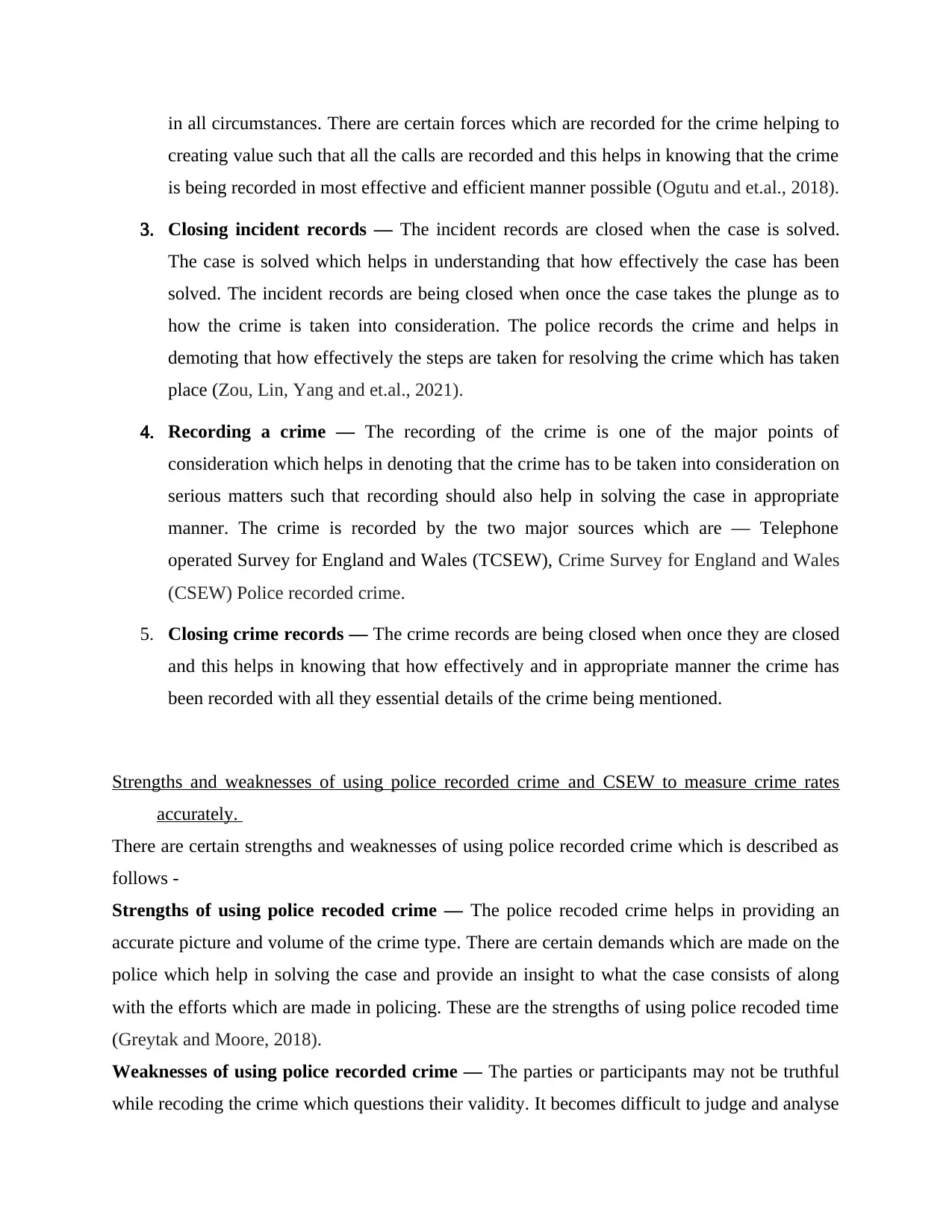
in all circumstances. There are certain forces which are recorded for the crime helping to
creating value such that all the calls are recorded and this helps in knowing that the crime
is being recorded in most effective and efficient manner possible (Ogutu and et.al., 2018).
3. Closing incident records — The incident records are closed when the case is solved.
The case is solved which helps in understanding that how effectively the case has been
solved. The incident records are being closed when once the case takes the plunge as to
how the crime is taken into consideration. The police records the crime and helps in
demoting that how effectively the steps are taken for resolving the crime which has taken
place (Zou, Lin, Yang and et.al., 2021).
4. Recording a crime — The recording of the crime is one of the major points of
consideration which helps in denoting that the crime has to be taken into consideration on
serious matters such that recording should also help in solving the case in appropriate
manner. The crime is recorded by the two major sources which are — Telephone
operated Survey for England and Wales (TCSEW), Crime Survey for England and Wales
(CSEW) Police recorded crime.
5. Closing crime records — The crime records are being closed when once they are closed
and this helps in knowing that how effectively and in appropriate manner the crime has
been recorded with all they essential details of the crime being mentioned.
Strengths and weaknesses of using police recorded crime and CSEW to measure crime rates
accurately.
There are certain strengths and weaknesses of using police recorded crime which is described as
follows -
Strengths of using police recoded crime — The police recoded crime helps in providing an
accurate picture and volume of the crime type. There are certain demands which are made on the
police which help in solving the case and provide an insight to what the case consists of along
with the efforts which are made in policing. These are the strengths of using police recoded time
(Greytak and Moore, 2018).
Weaknesses of using police recorded crime — The parties or participants may not be truthful
while recoding the crime which questions their validity. It becomes difficult to judge and analyse
creating value such that all the calls are recorded and this helps in knowing that the crime
is being recorded in most effective and efficient manner possible (Ogutu and et.al., 2018).
3. Closing incident records — The incident records are closed when the case is solved.
The case is solved which helps in understanding that how effectively the case has been
solved. The incident records are being closed when once the case takes the plunge as to
how the crime is taken into consideration. The police records the crime and helps in
demoting that how effectively the steps are taken for resolving the crime which has taken
place (Zou, Lin, Yang and et.al., 2021).
4. Recording a crime — The recording of the crime is one of the major points of
consideration which helps in denoting that the crime has to be taken into consideration on
serious matters such that recording should also help in solving the case in appropriate
manner. The crime is recorded by the two major sources which are — Telephone
operated Survey for England and Wales (TCSEW), Crime Survey for England and Wales
(CSEW) Police recorded crime.
5. Closing crime records — The crime records are being closed when once they are closed
and this helps in knowing that how effectively and in appropriate manner the crime has
been recorded with all they essential details of the crime being mentioned.
Strengths and weaknesses of using police recorded crime and CSEW to measure crime rates
accurately.
There are certain strengths and weaknesses of using police recorded crime which is described as
follows -
Strengths of using police recoded crime — The police recoded crime helps in providing an
accurate picture and volume of the crime type. There are certain demands which are made on the
police which help in solving the case and provide an insight to what the case consists of along
with the efforts which are made in policing. These are the strengths of using police recoded time
(Greytak and Moore, 2018).
Weaknesses of using police recorded crime — The parties or participants may not be truthful
while recoding the crime which questions their validity. It becomes difficult to judge and analyse
Secure Best Marks with AI Grader
Need help grading? Try our AI Grader for instant feedback on your assignments.
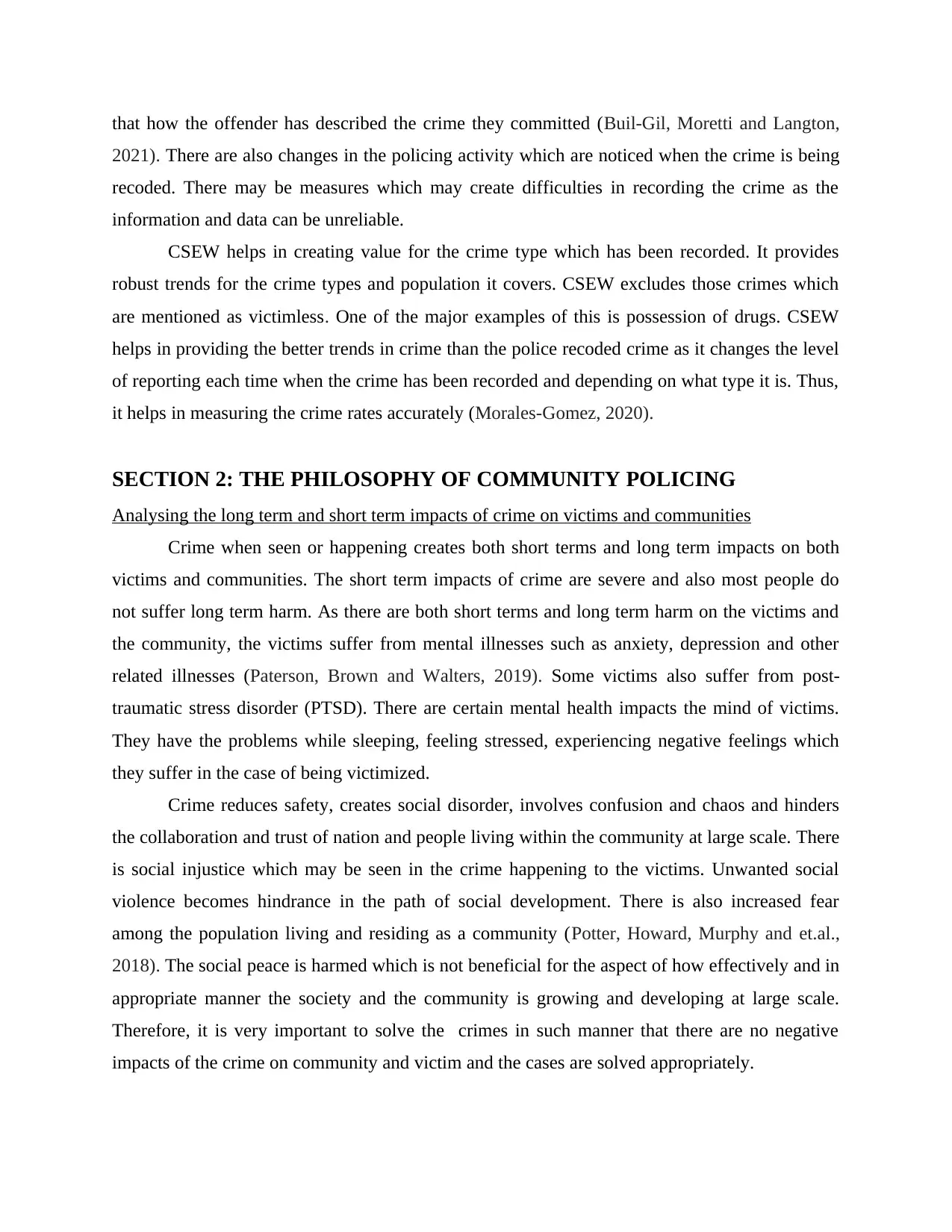
that how the offender has described the crime they committed (Buil-Gil, Moretti and Langton,
2021). There are also changes in the policing activity which are noticed when the crime is being
recoded. There may be measures which may create difficulties in recording the crime as the
information and data can be unreliable.
CSEW helps in creating value for the crime type which has been recorded. It provides
robust trends for the crime types and population it covers. CSEW excludes those crimes which
are mentioned as victimless. One of the major examples of this is possession of drugs. CSEW
helps in providing the better trends in crime than the police recoded crime as it changes the level
of reporting each time when the crime has been recorded and depending on what type it is. Thus,
it helps in measuring the crime rates accurately (Morales-Gomez, 2020).
SECTION 2: THE PHILOSOPHY OF COMMUNITY POLICING
Analysing the long term and short term impacts of crime on victims and communities
Crime when seen or happening creates both short terms and long term impacts on both
victims and communities. The short term impacts of crime are severe and also most people do
not suffer long term harm. As there are both short terms and long term harm on the victims and
the community, the victims suffer from mental illnesses such as anxiety, depression and other
related illnesses (Paterson, Brown and Walters, 2019). Some victims also suffer from post-
traumatic stress disorder (PTSD). There are certain mental health impacts the mind of victims.
They have the problems while sleeping, feeling stressed, experiencing negative feelings which
they suffer in the case of being victimized.
Crime reduces safety, creates social disorder, involves confusion and chaos and hinders
the collaboration and trust of nation and people living within the community at large scale. There
is social injustice which may be seen in the crime happening to the victims. Unwanted social
violence becomes hindrance in the path of social development. There is also increased fear
among the population living and residing as a community (Potter, Howard, Murphy and et.al.,
2018). The social peace is harmed which is not beneficial for the aspect of how effectively and in
appropriate manner the society and the community is growing and developing at large scale.
Therefore, it is very important to solve the crimes in such manner that there are no negative
impacts of the crime on community and victim and the cases are solved appropriately.
2021). There are also changes in the policing activity which are noticed when the crime is being
recoded. There may be measures which may create difficulties in recording the crime as the
information and data can be unreliable.
CSEW helps in creating value for the crime type which has been recorded. It provides
robust trends for the crime types and population it covers. CSEW excludes those crimes which
are mentioned as victimless. One of the major examples of this is possession of drugs. CSEW
helps in providing the better trends in crime than the police recoded crime as it changes the level
of reporting each time when the crime has been recorded and depending on what type it is. Thus,
it helps in measuring the crime rates accurately (Morales-Gomez, 2020).
SECTION 2: THE PHILOSOPHY OF COMMUNITY POLICING
Analysing the long term and short term impacts of crime on victims and communities
Crime when seen or happening creates both short terms and long term impacts on both
victims and communities. The short term impacts of crime are severe and also most people do
not suffer long term harm. As there are both short terms and long term harm on the victims and
the community, the victims suffer from mental illnesses such as anxiety, depression and other
related illnesses (Paterson, Brown and Walters, 2019). Some victims also suffer from post-
traumatic stress disorder (PTSD). There are certain mental health impacts the mind of victims.
They have the problems while sleeping, feeling stressed, experiencing negative feelings which
they suffer in the case of being victimized.
Crime reduces safety, creates social disorder, involves confusion and chaos and hinders
the collaboration and trust of nation and people living within the community at large scale. There
is social injustice which may be seen in the crime happening to the victims. Unwanted social
violence becomes hindrance in the path of social development. There is also increased fear
among the population living and residing as a community (Potter, Howard, Murphy and et.al.,
2018). The social peace is harmed which is not beneficial for the aspect of how effectively and in
appropriate manner the society and the community is growing and developing at large scale.
Therefore, it is very important to solve the crimes in such manner that there are no negative
impacts of the crime on community and victim and the cases are solved appropriately.
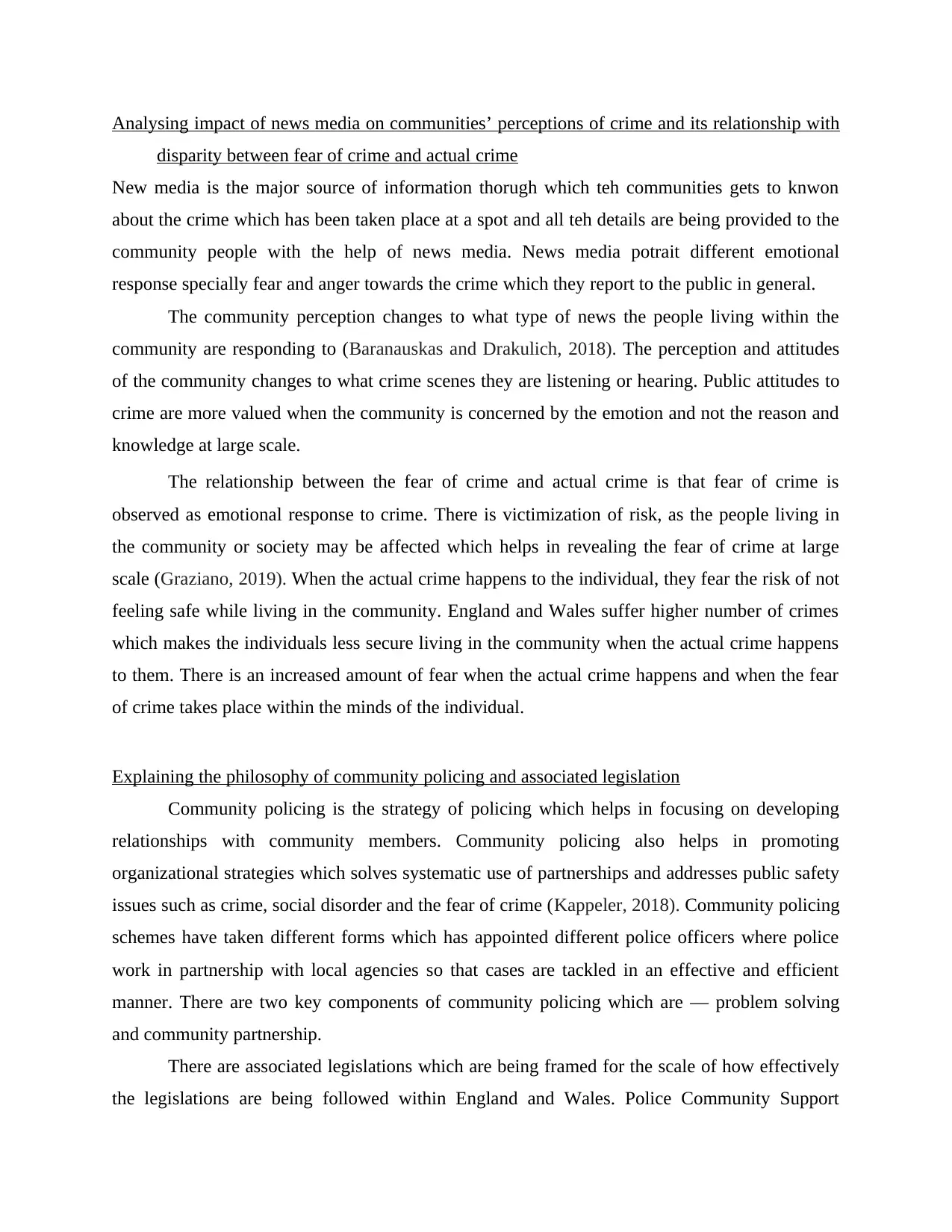
Analysing impact of news media on communities’ perceptions of crime and its relationship with
disparity between fear of crime and actual crime
New media is the major source of information thorugh which teh communities gets to knwon
about the crime which has been taken place at a spot and all teh details are being provided to the
community people with the help of news media. News media potrait different emotional
response specially fear and anger towards the crime which they report to the public in general.
The community perception changes to what type of news the people living within the
community are responding to (Baranauskas and Drakulich, 2018). The perception and attitudes
of the community changes to what crime scenes they are listening or hearing. Public attitudes to
crime are more valued when the community is concerned by the emotion and not the reason and
knowledge at large scale.
The relationship between the fear of crime and actual crime is that fear of crime is
observed as emotional response to crime. There is victimization of risk, as the people living in
the community or society may be affected which helps in revealing the fear of crime at large
scale (Graziano, 2019). When the actual crime happens to the individual, they fear the risk of not
feeling safe while living in the community. England and Wales suffer higher number of crimes
which makes the individuals less secure living in the community when the actual crime happens
to them. There is an increased amount of fear when the actual crime happens and when the fear
of crime takes place within the minds of the individual.
Explaining the philosophy of community policing and associated legislation
Community policing is the strategy of policing which helps in focusing on developing
relationships with community members. Community policing also helps in promoting
organizational strategies which solves systematic use of partnerships and addresses public safety
issues such as crime, social disorder and the fear of crime (Kappeler, 2018). Community policing
schemes have taken different forms which has appointed different police officers where police
work in partnership with local agencies so that cases are tackled in an effective and efficient
manner. There are two key components of community policing which are — problem solving
and community partnership.
There are associated legislations which are being framed for the scale of how effectively
the legislations are being followed within England and Wales. Police Community Support
disparity between fear of crime and actual crime
New media is the major source of information thorugh which teh communities gets to knwon
about the crime which has been taken place at a spot and all teh details are being provided to the
community people with the help of news media. News media potrait different emotional
response specially fear and anger towards the crime which they report to the public in general.
The community perception changes to what type of news the people living within the
community are responding to (Baranauskas and Drakulich, 2018). The perception and attitudes
of the community changes to what crime scenes they are listening or hearing. Public attitudes to
crime are more valued when the community is concerned by the emotion and not the reason and
knowledge at large scale.
The relationship between the fear of crime and actual crime is that fear of crime is
observed as emotional response to crime. There is victimization of risk, as the people living in
the community or society may be affected which helps in revealing the fear of crime at large
scale (Graziano, 2019). When the actual crime happens to the individual, they fear the risk of not
feeling safe while living in the community. England and Wales suffer higher number of crimes
which makes the individuals less secure living in the community when the actual crime happens
to them. There is an increased amount of fear when the actual crime happens and when the fear
of crime takes place within the minds of the individual.
Explaining the philosophy of community policing and associated legislation
Community policing is the strategy of policing which helps in focusing on developing
relationships with community members. Community policing also helps in promoting
organizational strategies which solves systematic use of partnerships and addresses public safety
issues such as crime, social disorder and the fear of crime (Kappeler, 2018). Community policing
schemes have taken different forms which has appointed different police officers where police
work in partnership with local agencies so that cases are tackled in an effective and efficient
manner. There are two key components of community policing which are — problem solving
and community partnership.
There are associated legislations which are being framed for the scale of how effectively
the legislations are being followed within England and Wales. Police Community Support
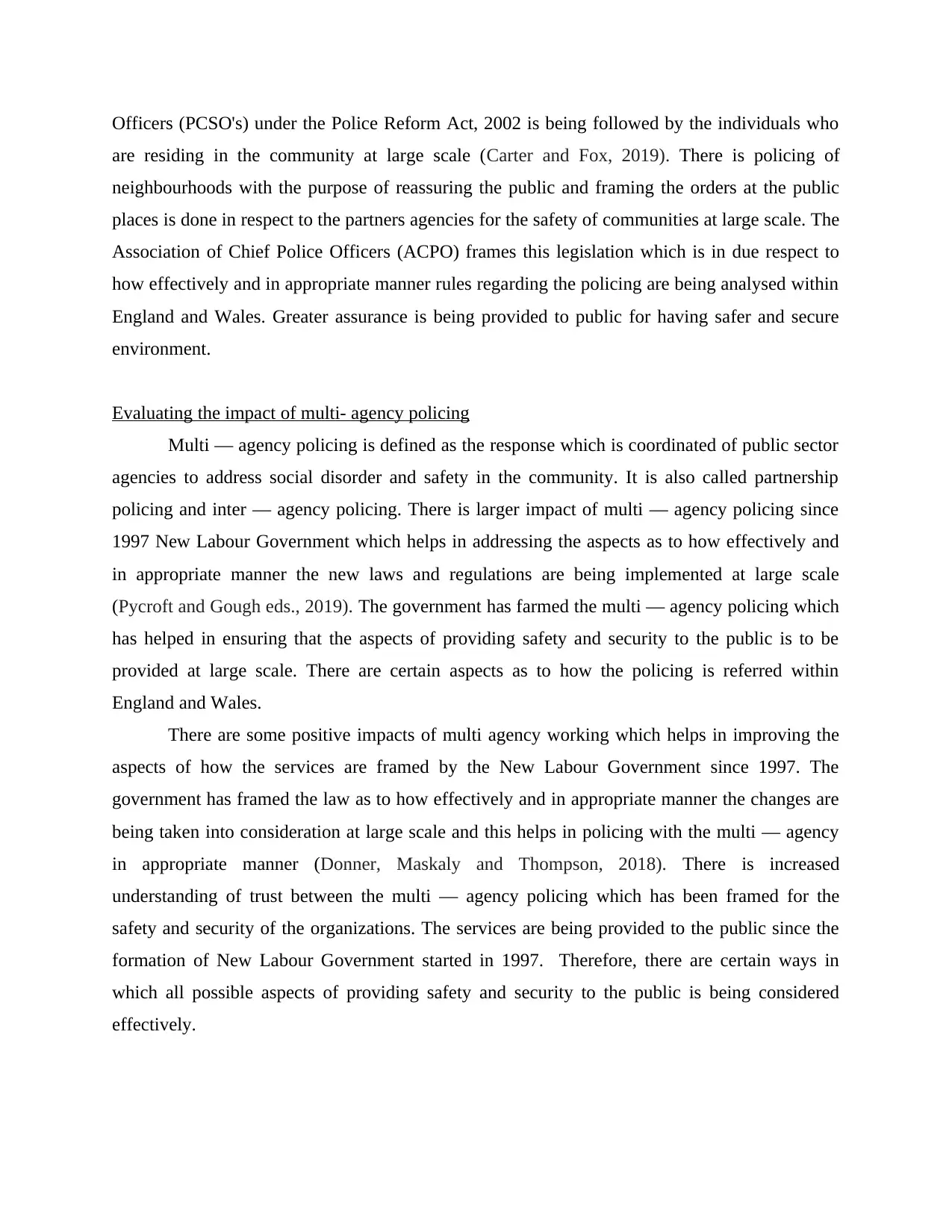
Officers (PCSO's) under the Police Reform Act, 2002 is being followed by the individuals who
are residing in the community at large scale (Carter and Fox, 2019). There is policing of
neighbourhoods with the purpose of reassuring the public and framing the orders at the public
places is done in respect to the partners agencies for the safety of communities at large scale. The
Association of Chief Police Officers (ACPO) frames this legislation which is in due respect to
how effectively and in appropriate manner rules regarding the policing are being analysed within
England and Wales. Greater assurance is being provided to public for having safer and secure
environment.
Evaluating the impact of multi- agency policing
Multi — agency policing is defined as the response which is coordinated of public sector
agencies to address social disorder and safety in the community. It is also called partnership
policing and inter — agency policing. There is larger impact of multi — agency policing since
1997 New Labour Government which helps in addressing the aspects as to how effectively and
in appropriate manner the new laws and regulations are being implemented at large scale
(Pycroft and Gough eds., 2019). The government has farmed the multi — agency policing which
has helped in ensuring that the aspects of providing safety and security to the public is to be
provided at large scale. There are certain aspects as to how the policing is referred within
England and Wales.
There are some positive impacts of multi agency working which helps in improving the
aspects of how the services are framed by the New Labour Government since 1997. The
government has framed the law as to how effectively and in appropriate manner the changes are
being taken into consideration at large scale and this helps in policing with the multi — agency
in appropriate manner (Donner, Maskaly and Thompson, 2018). There is increased
understanding of trust between the multi — agency policing which has been framed for the
safety and security of the organizations. The services are being provided to the public since the
formation of New Labour Government started in 1997. Therefore, there are certain ways in
which all possible aspects of providing safety and security to the public is being considered
effectively.
are residing in the community at large scale (Carter and Fox, 2019). There is policing of
neighbourhoods with the purpose of reassuring the public and framing the orders at the public
places is done in respect to the partners agencies for the safety of communities at large scale. The
Association of Chief Police Officers (ACPO) frames this legislation which is in due respect to
how effectively and in appropriate manner rules regarding the policing are being analysed within
England and Wales. Greater assurance is being provided to public for having safer and secure
environment.
Evaluating the impact of multi- agency policing
Multi — agency policing is defined as the response which is coordinated of public sector
agencies to address social disorder and safety in the community. It is also called partnership
policing and inter — agency policing. There is larger impact of multi — agency policing since
1997 New Labour Government which helps in addressing the aspects as to how effectively and
in appropriate manner the new laws and regulations are being implemented at large scale
(Pycroft and Gough eds., 2019). The government has farmed the multi — agency policing which
has helped in ensuring that the aspects of providing safety and security to the public is to be
provided at large scale. There are certain aspects as to how the policing is referred within
England and Wales.
There are some positive impacts of multi agency working which helps in improving the
aspects of how the services are framed by the New Labour Government since 1997. The
government has framed the law as to how effectively and in appropriate manner the changes are
being taken into consideration at large scale and this helps in policing with the multi — agency
in appropriate manner (Donner, Maskaly and Thompson, 2018). There is increased
understanding of trust between the multi — agency policing which has been framed for the
safety and security of the organizations. The services are being provided to the public since the
formation of New Labour Government started in 1997. Therefore, there are certain ways in
which all possible aspects of providing safety and security to the public is being considered
effectively.
Paraphrase This Document
Need a fresh take? Get an instant paraphrase of this document with our AI Paraphraser
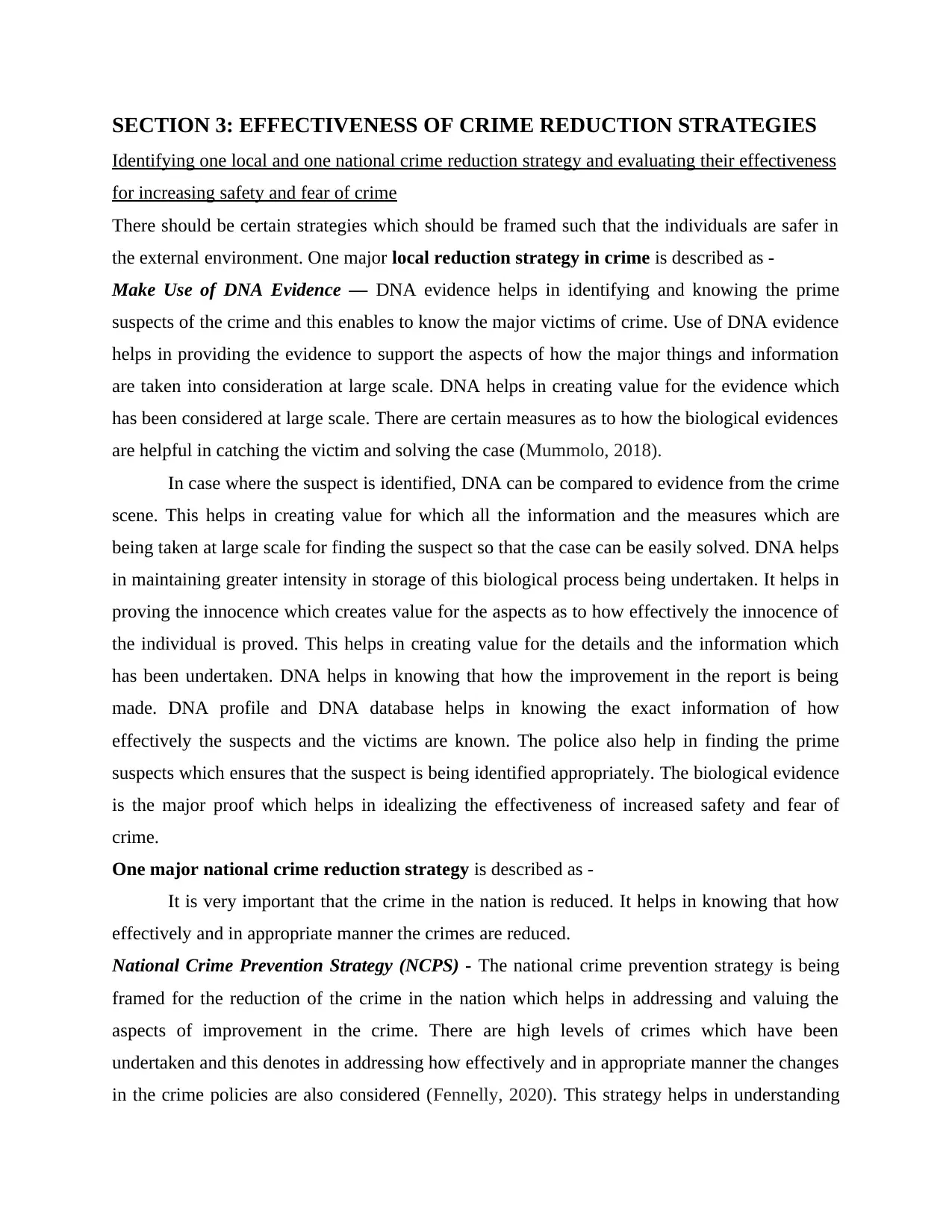
SECTION 3: EFFECTIVENESS OF CRIME REDUCTION STRATEGIES
Identifying one local and one national crime reduction strategy and evaluating their effectiveness
for increasing safety and fear of crime
There should be certain strategies which should be framed such that the individuals are safer in
the external environment. One major local reduction strategy in crime is described as -
Make Use of DNA Evidence — DNA evidence helps in identifying and knowing the prime
suspects of the crime and this enables to know the major victims of crime. Use of DNA evidence
helps in providing the evidence to support the aspects of how the major things and information
are taken into consideration at large scale. DNA helps in creating value for the evidence which
has been considered at large scale. There are certain measures as to how the biological evidences
are helpful in catching the victim and solving the case (Mummolo, 2018).
In case where the suspect is identified, DNA can be compared to evidence from the crime
scene. This helps in creating value for which all the information and the measures which are
being taken at large scale for finding the suspect so that the case can be easily solved. DNA helps
in maintaining greater intensity in storage of this biological process being undertaken. It helps in
proving the innocence which creates value for the aspects as to how effectively the innocence of
the individual is proved. This helps in creating value for the details and the information which
has been undertaken. DNA helps in knowing that how the improvement in the report is being
made. DNA profile and DNA database helps in knowing the exact information of how
effectively the suspects and the victims are known. The police also help in finding the prime
suspects which ensures that the suspect is being identified appropriately. The biological evidence
is the major proof which helps in idealizing the effectiveness of increased safety and fear of
crime.
One major national crime reduction strategy is described as -
It is very important that the crime in the nation is reduced. It helps in knowing that how
effectively and in appropriate manner the crimes are reduced.
National Crime Prevention Strategy (NCPS) - The national crime prevention strategy is being
framed for the reduction of the crime in the nation which helps in addressing and valuing the
aspects of improvement in the crime. There are high levels of crimes which have been
undertaken and this denotes in addressing how effectively and in appropriate manner the changes
in the crime policies are also considered (Fennelly, 2020). This strategy helps in understanding
Identifying one local and one national crime reduction strategy and evaluating their effectiveness
for increasing safety and fear of crime
There should be certain strategies which should be framed such that the individuals are safer in
the external environment. One major local reduction strategy in crime is described as -
Make Use of DNA Evidence — DNA evidence helps in identifying and knowing the prime
suspects of the crime and this enables to know the major victims of crime. Use of DNA evidence
helps in providing the evidence to support the aspects of how the major things and information
are taken into consideration at large scale. DNA helps in creating value for the evidence which
has been considered at large scale. There are certain measures as to how the biological evidences
are helpful in catching the victim and solving the case (Mummolo, 2018).
In case where the suspect is identified, DNA can be compared to evidence from the crime
scene. This helps in creating value for which all the information and the measures which are
being taken at large scale for finding the suspect so that the case can be easily solved. DNA helps
in maintaining greater intensity in storage of this biological process being undertaken. It helps in
proving the innocence which creates value for the aspects as to how effectively the innocence of
the individual is proved. This helps in creating value for the details and the information which
has been undertaken. DNA helps in knowing that how the improvement in the report is being
made. DNA profile and DNA database helps in knowing the exact information of how
effectively the suspects and the victims are known. The police also help in finding the prime
suspects which ensures that the suspect is being identified appropriately. The biological evidence
is the major proof which helps in idealizing the effectiveness of increased safety and fear of
crime.
One major national crime reduction strategy is described as -
It is very important that the crime in the nation is reduced. It helps in knowing that how
effectively and in appropriate manner the crimes are reduced.
National Crime Prevention Strategy (NCPS) - The national crime prevention strategy is being
framed for the reduction of the crime in the nation which helps in addressing and valuing the
aspects of improvement in the crime. There are high levels of crimes which have been
undertaken and this denotes in addressing how effectively and in appropriate manner the changes
in the crime policies are also considered (Fennelly, 2020). This strategy helps in understanding
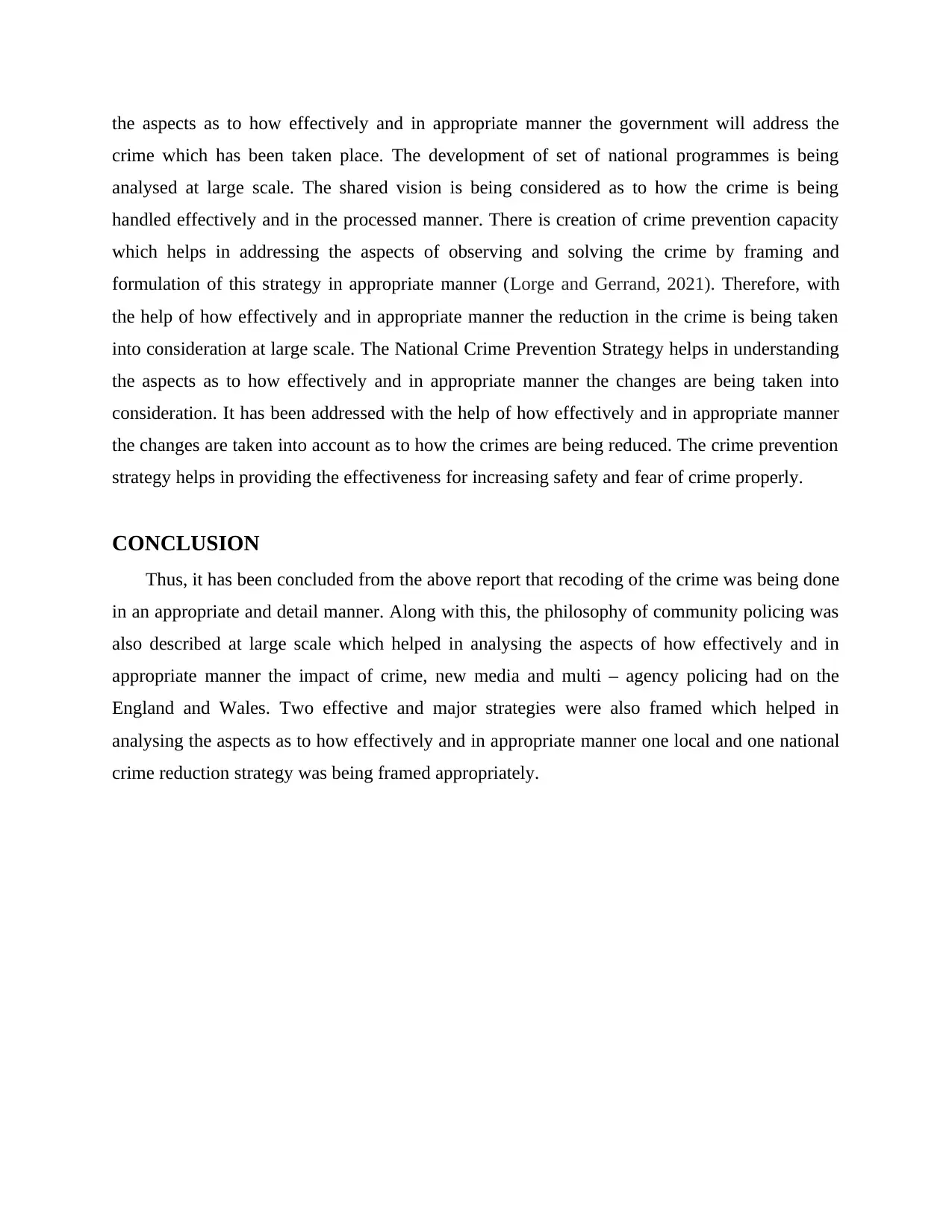
the aspects as to how effectively and in appropriate manner the government will address the
crime which has been taken place. The development of set of national programmes is being
analysed at large scale. The shared vision is being considered as to how the crime is being
handled effectively and in the processed manner. There is creation of crime prevention capacity
which helps in addressing the aspects of observing and solving the crime by framing and
formulation of this strategy in appropriate manner (Lorge and Gerrand, 2021). Therefore, with
the help of how effectively and in appropriate manner the reduction in the crime is being taken
into consideration at large scale. The National Crime Prevention Strategy helps in understanding
the aspects as to how effectively and in appropriate manner the changes are being taken into
consideration. It has been addressed with the help of how effectively and in appropriate manner
the changes are taken into account as to how the crimes are being reduced. The crime prevention
strategy helps in providing the effectiveness for increasing safety and fear of crime properly.
CONCLUSION
Thus, it has been concluded from the above report that recoding of the crime was being done
in an appropriate and detail manner. Along with this, the philosophy of community policing was
also described at large scale which helped in analysing the aspects of how effectively and in
appropriate manner the impact of crime, new media and multi – agency policing had on the
England and Wales. Two effective and major strategies were also framed which helped in
analysing the aspects as to how effectively and in appropriate manner one local and one national
crime reduction strategy was being framed appropriately.
crime which has been taken place. The development of set of national programmes is being
analysed at large scale. The shared vision is being considered as to how the crime is being
handled effectively and in the processed manner. There is creation of crime prevention capacity
which helps in addressing the aspects of observing and solving the crime by framing and
formulation of this strategy in appropriate manner (Lorge and Gerrand, 2021). Therefore, with
the help of how effectively and in appropriate manner the reduction in the crime is being taken
into consideration at large scale. The National Crime Prevention Strategy helps in understanding
the aspects as to how effectively and in appropriate manner the changes are being taken into
consideration. It has been addressed with the help of how effectively and in appropriate manner
the changes are taken into account as to how the crimes are being reduced. The crime prevention
strategy helps in providing the effectiveness for increasing safety and fear of crime properly.
CONCLUSION
Thus, it has been concluded from the above report that recoding of the crime was being done
in an appropriate and detail manner. Along with this, the philosophy of community policing was
also described at large scale which helped in analysing the aspects of how effectively and in
appropriate manner the impact of crime, new media and multi – agency policing had on the
England and Wales. Two effective and major strategies were also framed which helped in
analysing the aspects as to how effectively and in appropriate manner one local and one national
crime reduction strategy was being framed appropriately.
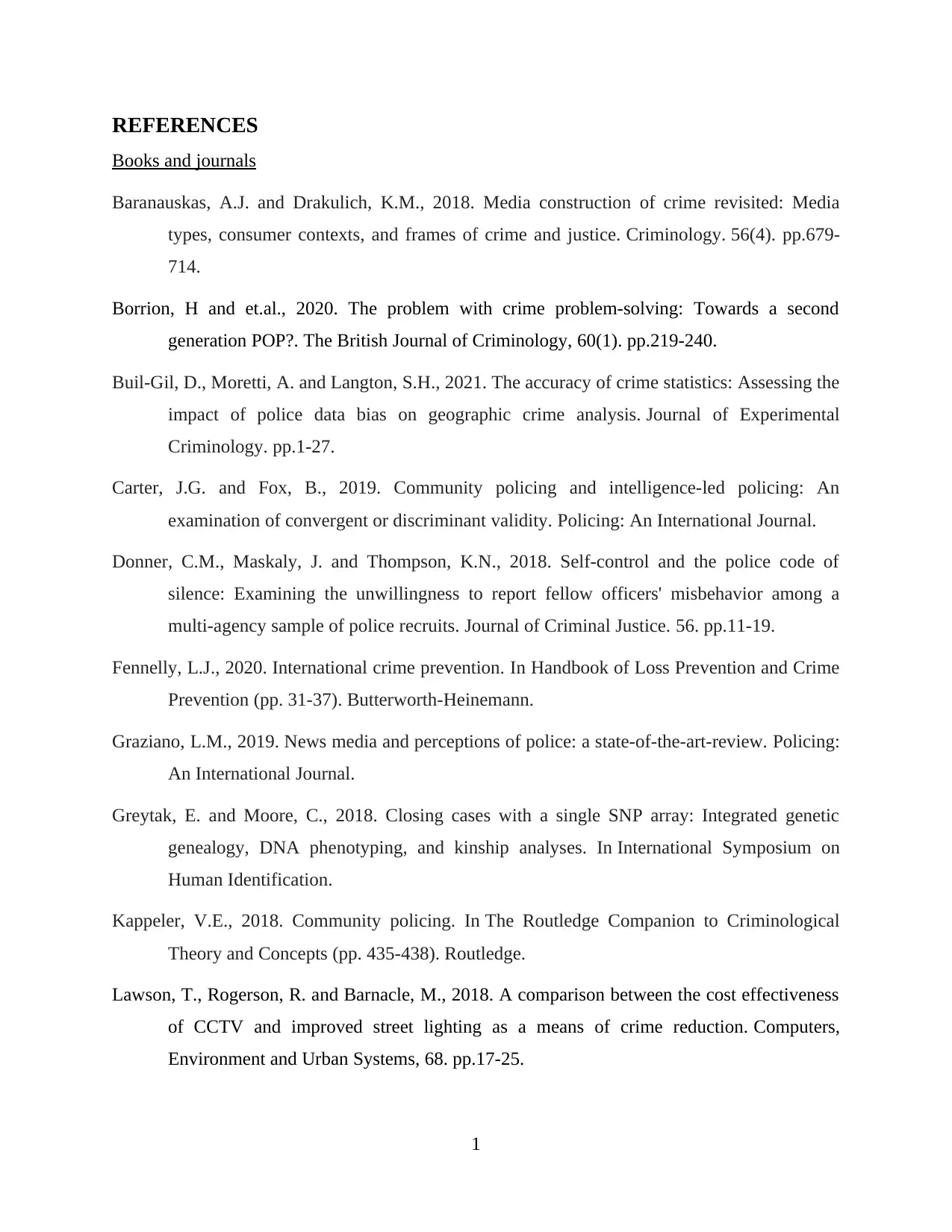
REFERENCES
Books and journals
Baranauskas, A.J. and Drakulich, K.M., 2018. Media construction of crime revisited: Media
types, consumer contexts, and frames of crime and justice. Criminology. 56(4). pp.679-
714.
Borrion, H and et.al., 2020. The problem with crime problem-solving: Towards a second
generation POP?. The British Journal of Criminology, 60(1). pp.219-240.
Buil-Gil, D., Moretti, A. and Langton, S.H., 2021. The accuracy of crime statistics: Assessing the
impact of police data bias on geographic crime analysis. Journal of Experimental
Criminology. pp.1-27.
Carter, J.G. and Fox, B., 2019. Community policing and intelligence-led policing: An
examination of convergent or discriminant validity. Policing: An International Journal.
Donner, C.M., Maskaly, J. and Thompson, K.N., 2018. Self-control and the police code of
silence: Examining the unwillingness to report fellow officers' misbehavior among a
multi-agency sample of police recruits. Journal of Criminal Justice. 56. pp.11-19.
Fennelly, L.J., 2020. International crime prevention. In Handbook of Loss Prevention and Crime
Prevention (pp. 31-37). Butterworth-Heinemann.
Graziano, L.M., 2019. News media and perceptions of police: a state-of-the-art-review. Policing:
An International Journal.
Greytak, E. and Moore, C., 2018. Closing cases with a single SNP array: Integrated genetic
genealogy, DNA phenotyping, and kinship analyses. In International Symposium on
Human Identification.
Kappeler, V.E., 2018. Community policing. In The Routledge Companion to Criminological
Theory and Concepts (pp. 435-438). Routledge.
Lawson, T., Rogerson, R. and Barnacle, M., 2018. A comparison between the cost effectiveness
of CCTV and improved street lighting as a means of crime reduction. Computers,
Environment and Urban Systems, 68. pp.17-25.
1
Books and journals
Baranauskas, A.J. and Drakulich, K.M., 2018. Media construction of crime revisited: Media
types, consumer contexts, and frames of crime and justice. Criminology. 56(4). pp.679-
714.
Borrion, H and et.al., 2020. The problem with crime problem-solving: Towards a second
generation POP?. The British Journal of Criminology, 60(1). pp.219-240.
Buil-Gil, D., Moretti, A. and Langton, S.H., 2021. The accuracy of crime statistics: Assessing the
impact of police data bias on geographic crime analysis. Journal of Experimental
Criminology. pp.1-27.
Carter, J.G. and Fox, B., 2019. Community policing and intelligence-led policing: An
examination of convergent or discriminant validity. Policing: An International Journal.
Donner, C.M., Maskaly, J. and Thompson, K.N., 2018. Self-control and the police code of
silence: Examining the unwillingness to report fellow officers' misbehavior among a
multi-agency sample of police recruits. Journal of Criminal Justice. 56. pp.11-19.
Fennelly, L.J., 2020. International crime prevention. In Handbook of Loss Prevention and Crime
Prevention (pp. 31-37). Butterworth-Heinemann.
Graziano, L.M., 2019. News media and perceptions of police: a state-of-the-art-review. Policing:
An International Journal.
Greytak, E. and Moore, C., 2018. Closing cases with a single SNP array: Integrated genetic
genealogy, DNA phenotyping, and kinship analyses. In International Symposium on
Human Identification.
Kappeler, V.E., 2018. Community policing. In The Routledge Companion to Criminological
Theory and Concepts (pp. 435-438). Routledge.
Lawson, T., Rogerson, R. and Barnacle, M., 2018. A comparison between the cost effectiveness
of CCTV and improved street lighting as a means of crime reduction. Computers,
Environment and Urban Systems, 68. pp.17-25.
1
Secure Best Marks with AI Grader
Need help grading? Try our AI Grader for instant feedback on your assignments.
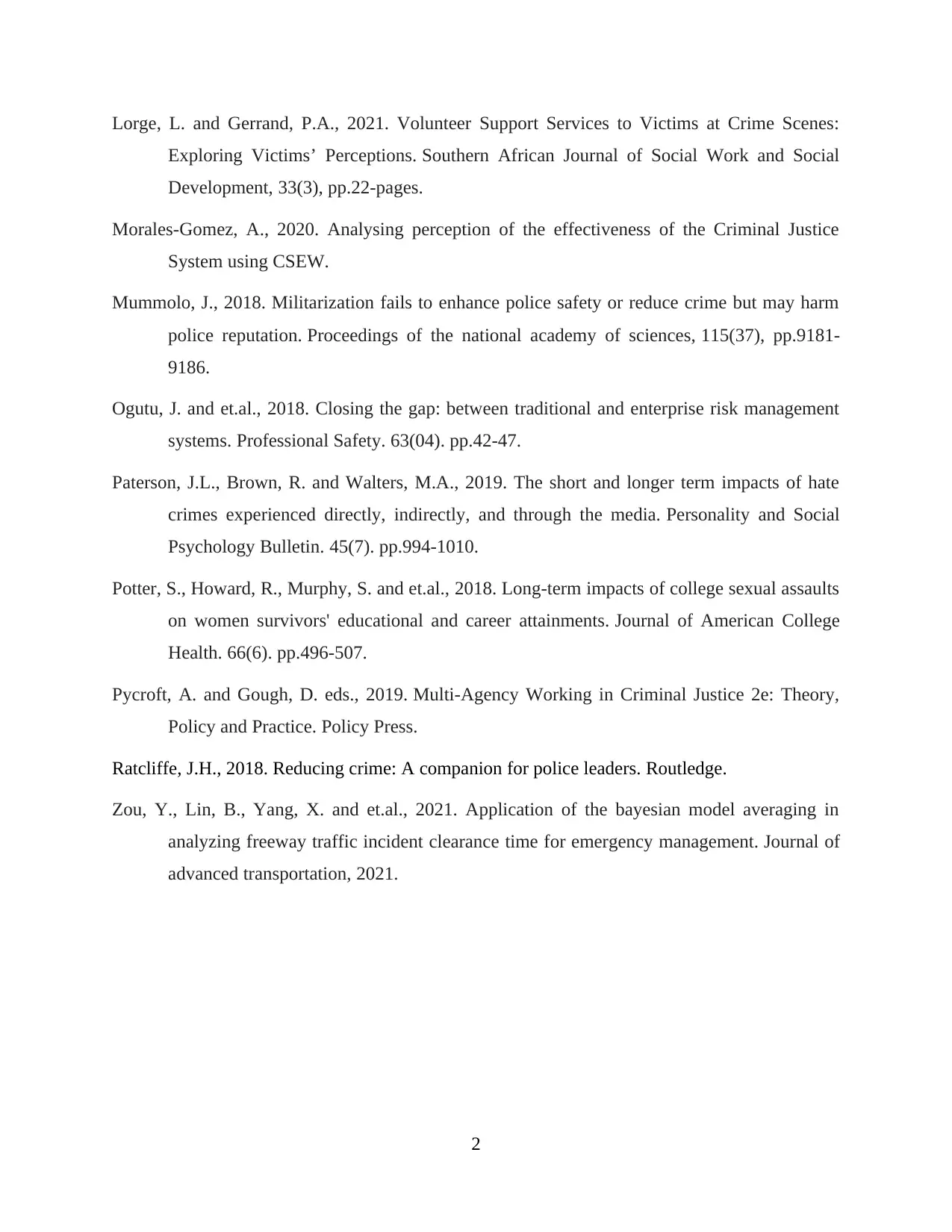
Lorge, L. and Gerrand, P.A., 2021. Volunteer Support Services to Victims at Crime Scenes:
Exploring Victims’ Perceptions. Southern African Journal of Social Work and Social
Development, 33(3), pp.22-pages.
Morales-Gomez, A., 2020. Analysing perception of the effectiveness of the Criminal Justice
System using CSEW.
Mummolo, J., 2018. Militarization fails to enhance police safety or reduce crime but may harm
police reputation. Proceedings of the national academy of sciences, 115(37), pp.9181-
9186.
Ogutu, J. and et.al., 2018. Closing the gap: between traditional and enterprise risk management
systems. Professional Safety. 63(04). pp.42-47.
Paterson, J.L., Brown, R. and Walters, M.A., 2019. The short and longer term impacts of hate
crimes experienced directly, indirectly, and through the media. Personality and Social
Psychology Bulletin. 45(7). pp.994-1010.
Potter, S., Howard, R., Murphy, S. and et.al., 2018. Long-term impacts of college sexual assaults
on women survivors' educational and career attainments. Journal of American College
Health. 66(6). pp.496-507.
Pycroft, A. and Gough, D. eds., 2019. Multi-Agency Working in Criminal Justice 2e: Theory,
Policy and Practice. Policy Press.
Ratcliffe, J.H., 2018. Reducing crime: A companion for police leaders. Routledge.
Zou, Y., Lin, B., Yang, X. and et.al., 2021. Application of the bayesian model averaging in
analyzing freeway traffic incident clearance time for emergency management. Journal of
advanced transportation, 2021.
2
Exploring Victims’ Perceptions. Southern African Journal of Social Work and Social
Development, 33(3), pp.22-pages.
Morales-Gomez, A., 2020. Analysing perception of the effectiveness of the Criminal Justice
System using CSEW.
Mummolo, J., 2018. Militarization fails to enhance police safety or reduce crime but may harm
police reputation. Proceedings of the national academy of sciences, 115(37), pp.9181-
9186.
Ogutu, J. and et.al., 2018. Closing the gap: between traditional and enterprise risk management
systems. Professional Safety. 63(04). pp.42-47.
Paterson, J.L., Brown, R. and Walters, M.A., 2019. The short and longer term impacts of hate
crimes experienced directly, indirectly, and through the media. Personality and Social
Psychology Bulletin. 45(7). pp.994-1010.
Potter, S., Howard, R., Murphy, S. and et.al., 2018. Long-term impacts of college sexual assaults
on women survivors' educational and career attainments. Journal of American College
Health. 66(6). pp.496-507.
Pycroft, A. and Gough, D. eds., 2019. Multi-Agency Working in Criminal Justice 2e: Theory,
Policy and Practice. Policy Press.
Ratcliffe, J.H., 2018. Reducing crime: A companion for police leaders. Routledge.
Zou, Y., Lin, B., Yang, X. and et.al., 2021. Application of the bayesian model averaging in
analyzing freeway traffic incident clearance time for emergency management. Journal of
advanced transportation, 2021.
2
1 out of 11
Related Documents
Your All-in-One AI-Powered Toolkit for Academic Success.
+13062052269
info@desklib.com
Available 24*7 on WhatsApp / Email
![[object Object]](/_next/static/media/star-bottom.7253800d.svg)
Unlock your academic potential
© 2024 | Zucol Services PVT LTD | All rights reserved.





